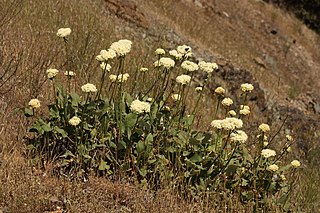
Eriogonum is a genus of flowering plants in the family Polygonaceae. The genus is found in North America and is known as wild buckwheat. This is a highly species-rich genus, and indications are that active speciation is continuing. It includes some common wildflowers such as the California buckwheat.

Eriogonum nudum is a perennial shrub of the wild buckwheat genus which is known by the common name naked buckwheat or nude buckwheat.
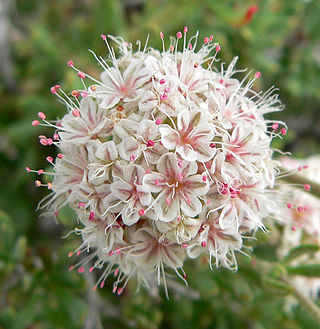
Eriogonum fasciculatum is a species of wild buckwheat known by the common names California buckwheat and flat-topped buckwheat. Characterized by small, white and pink flower clusters that give off a cottony effect, this species grows variably from a patchy mat to a wide shrub, with the flowers turning a rusty color after blooming. This plant is of great benefit across its various habitats, providing an important food resource for a diversity of insect and mammal species. It also provides numerous ecosystem services for humans, including erosion control, post-fire mitigation, increases in crop yields when planted in hedgerows, and high habitat restoration value.
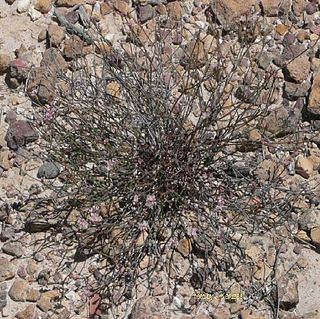
Eriogonum apricum is a rare species of wild buckwheat known by the common name Ione buckwheat. It is endemic to Amador County, California, in the United States.

Eriogonum deflexum is a species of wild buckwheat known by the common names flatcrown buckwheat, flat-top buckwheat, and skeletonweed. This plant is native to the southwestern United States and northwestern Mexico, where it is common and grows in a variety of habitats, especially desert scrub. It is somewhat weedy where it is most abundant. This is an annual which varies in size from small patches on the ground to tangled bushes approaching two meters in height; it may be dense or thin and spindly. This is a brown or greenish weedy-looking herb with a many-branched stem. The leaves are located at the base of the plant and are rounded and woolly and one to four centimeters long. Small clusters of flowers appear at intervals along the branches with each flower only one to three millimeters wide and white or pinkish in color.
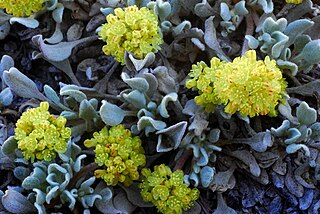
Eriogonum diclinum is a species of wild buckwheat known by the common name Jaynes Canyon buckwheat. It is native to the Klamath Mountains of northern California and southern Oregon, where it is an uncommon member of plant communities on serpentine soils. This is a small dioecious shrub forming low, thick mats rarely exceeding 20 centimeters in height. The curving, oval-shaped leaves are woolly and greenish gray in color, growing up to two centimeters long. The plant flowers in yellow to reddish rounded inflorescences, male plants producing clusters of staminate flowers, and female plants producing larger clusters of pistillate flowers.

Eriogonum elatum is a species of wild buckwheat known by the common name tall woolly buckwheat. It is native to the western United States from California to Idaho. It is a perennial herb varying in size from one half to 1.5 meters in height. Its long leaves are located at the base of the plant and can be quite long for a buckwheat, over 20 centimeters in maximum length. The erect, branching stems are thin and naked and occasionally hollow. The plant produces small to large inflorescences with clusters of tiny flowers in shades of white to dark pink.
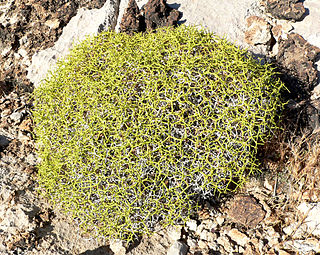
Eriogonum heermannii is a species of wild buckwheat known by the common name Heermann's buckwheat. It is native to the southwestern United States from California to Utah where it grows on rocky slopes, desert flats, and dry washes.

Eriogonum intrafractum is a species of wild buckwheat known by the common names jointed buckwheat and napkinring. This plant is endemic to Inyo County, California, where it is known only from the mountain ranges surrounding Death Valley. It is an uncommon, distinctive perennial herb which grows in scattered patches on rocky limestone soils in these desert mountains.

Eriogonum ovalifolium is a species of wild buckwheat known by the common name cushion buckwheat. It is native to western North America from California to Alberta, where it is a member of many plant communities in varied habitats, including the sagebrush steppe and alpine regions.

Eriogonum ampullaceum is a species of wild buckwheat known by the common name Mono buckwheat.

Eriogonum angulosum is a species of wild buckwheat known by the common name anglestem buckwheat.
Eriogonum deserticola is a species of wild buckwheat known by the common name Colorado Desert buckwheat.

Eriogonum eremicola is a rare species of wild buckwheat known by the common names Telescope Peak buckwheat and Wild Rose Canyon buckwheat. It is endemic to Inyo County, California, where it is known from only a few occurrences in the Inyo Mountains and Telescope Peak in Death Valley. It grows in sandy to rocky habitat in the forests and woodlands of these desert mountains. It is an annual herb producing a spreading, glandular, reddish green stem up to about 25 centimeters tall. The rounded, woolly leaves are up to about 2.5 centimeters long and are located at the base of the stem. The scattered inflorescences are small clusters of tiny flowers which are white with reddish stripes, aging to solid red, or sometimes yellow. The plant is under protection in Death Valley National Park.
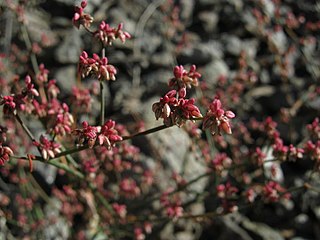
Eriogonum hoffmannii is a species of wild buckwheat known by the common name Hoffmann's buckwheat. It is endemic to Inyo County, California, where it is found only in the mountains around Death Valley; most of the known populations of the plant are located in Death Valley National Park. The plant grows in the desert scrub on the slopes of the Panamint, Black, and Funeral Mountains.

Eriogonum hookeri is a species of wild buckwheat known by the common name Hooker's buckwheat. It is native to the Intermountain West of the United States, where it grows in plateau and desert habitat.

Eriogonum sphaerocephalum is a species of wild buckwheat known by the common names rock buckwheat and round-headed desert buckwheat. It is native to the western United States.

Eriogonum thomasii is a species of wild buckwheat known by the common name Thurber's buckwheat. It is native to the desert southwest of North America in Arizona, California, New Mexico and three desert states of Mexico, where it is common to abundant in many areas.

Eriogonum argophyllum is a species of wild buckwheat known by the common names Sulphur Hot Springs buckwheat, Silver Lake buckwheat, and Ruby Valley buckwheat. It is endemic to Nevada in the United States, where there is only one known population.

Eriogonum codium is a species of wild buckwheat known by the common names basalt desert buckwheat and Umtanum Desert wild buckwheat. It is endemic to Washington in the United States, where it is known only from Hanford Reach National Monument in Benton County. It was discovered in 1995 during an inventory of the biodiversity of the monument and described to science in 1997.



















